EPtalk by Dr. Jayne 8/26/21
The big news of the week was the official FDA approval of the Pfizer COVID-19 vaccine, which in turn triggered a rush of corporations to mandate employee vaccinations. Those companies that want to offer alternatives will require regular testing in lieu of a vaccine. Others, such as Delta Airlines, will charge unvaccinated people a premium on their health insurance and will block them from receiving pay-protection funds if they become infected with COVID-19.
As a physician, I appreciate the Delta Airlines strategy since it’s trying to tie cause and effect. The reality is that unvaccinated people who contract COVID-19 have a much higher risk of hospitalization and higher odds of costing their employers money and hitting people in the pocketbook might be much more effective for some than current vaccination strategies.
Once a drug has formal FDA approval, that opens to door for clinicians to consider so-called off-label prescribing, where they recommend use of the drug outside of the official approval. Off-label prescribing is common with a number of medications. For example, while we were having a shortage of antibiotic ear drops last year, physicians substituted the same drug in an eye drop formulation, which is widely considered to be safe and effective.
The official FDA approval for the Pfizer vaccine was only for patients aged 16 and older. Those 12 to 15 are still covered under an Emergency Use Authorization. Still, in the early hours following approval, several sources in my area made a play to administer vaccine doses to 10- and 11-year-olds. A quick clarification from the FDA as well as the American Academy of Pediatrics made it clear that this shouldn’t be happening, and that prescribers need to wait for additional approvals in younger age groups. Part of the delay in younger patients involves evaluating the dosing, but given the relative size of some larger 11-year-olds compared to smaller 12- and 13-year-olds, the risk of harm in those few children who received “unauthorized” doses is likely to be small.
Regarding the potential for upcoming booster shots, a couple of my neighbors were discussing the idea of trying to jump the gun on a third dose. One of them heard that a local pharmacy was throwing away doses that were expiring, so went and presented herself like she was there to receive her first dose. My other neighbor was incredulous that someone would be able to do that, “because don’t they have a national database of who has received what kind of vaccine?” She was shocked to learn that immunization registries are a patchwork across the states, and that they’re often not bidirectional or fully interoperable with hospitals and health systems, let alone other states.
I had a similar conversation with a neighborhood mom after the local school district requested copies of vaccination cards for students so that they would have them on hand in the event of an exposure. She didn’t understand why the schools “just can’t get them from the pediatricians’ offices.” Lots of members of the general public assume healthcare technology is a lot farther along than it is. I look forward to the day we can really exchange data like we need to in order to better enable quality care.
Many of those organizations requiring vaccination are healthcare delivery organizations, who have a vested interest in not only keeping their workers healthy, but in helping reduce transmission between staff and patients. A recent Kaiser Family Foundation brief concluded that over the last two months, COVID-19 hospitalizations of unvaccinated patients has cost the health system $2.3 billion. For hospitals running on razor thin margins, there is likely to be a certain amount of uncompensated care that will never be recouped. Other costs will be absorbed by taxpayer-funded programs (Medicare, Medicaid) or passed on to workers or businesses. In other words, we’re all going to be paying for this debacle for a long time.
For those of us on the vendor side of the healthcare IT industry, this means hospitals will continue to be strapped for cash for the foreseeable future, reducing available funds for technology projects including upgrades and new solutions. In addition to funding challenges, hospitals and health systems are also focused on trying to recruit and retain staff while keeping overloaded clinical divisions working. They’re certainly not going to be as eager to hear from technology vendors as they might have been a couple of years ago unless they’ve identified something particular that needs resolution and can’t wait. I’ve watched many companies turnover their entire sales teams over the last year due to low sales, but it seems inevitable that organizations will be pinching pennies for months to come.
The Medical Group Management Association has announced that its October Medical Practice Excellence: Leaders Conference in San Diego will require full COVID-19 vaccination for all attendees, suppliers, speakers, and exhibitors. Attendees will have to interact with plenty of other personnel – hotel staff, transportation workers, and those at dining establishments as well as members of the public who aren’t attending the conference, so the conference won’t be able to create a complete bubble. As for masks, MGMA says “masks are strongly recommended for attendees.” but it appears the organization is holding off on announcing a mask mandate pending changing conditions.
The Healthcare Financial Management Association’s Annual Conference slated for Minneapolis in November will also be vaccination-required for those attending onsite. Unlike HIMSS, registrants are able to cancel penalty-free or they can switch to the digital version of the conference if they do not want to comply with the vaccination mandate. In addition to attendees, vaccination is required for speakers, exhibitors, volunteers, staff, and backstage crew.
In speaking with some of my vendor contacts, everyone is already in the thick of their HIMSS22 planning. It will be interesting to see what the winter conference season looks like, starting with the Consumer Electronics Show kicking off in January. I’m planning to attend digitally this year as I did last time and looking forward to seeing innovative new technologies as well as things that are just quirky.
What are you most looking forward to in 2022? Leave a comment or email me.

Email Dr. Jayne.


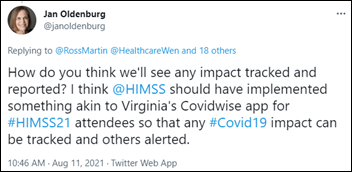

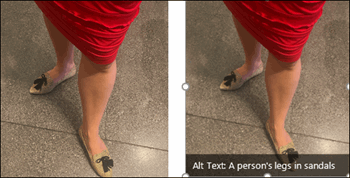




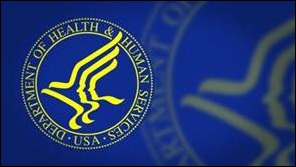
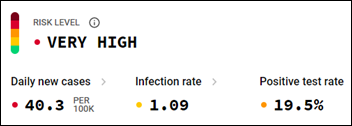


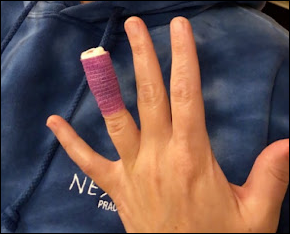

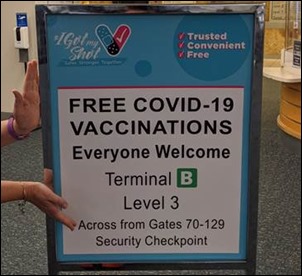


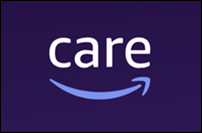
"A valid concern..." Oh please. Everyone picks the software they like and the origin of that software is an afterthought.…